Rimini: Travel in Italy’s off season uncovers an inexpensive, uncrowded gem on the sea
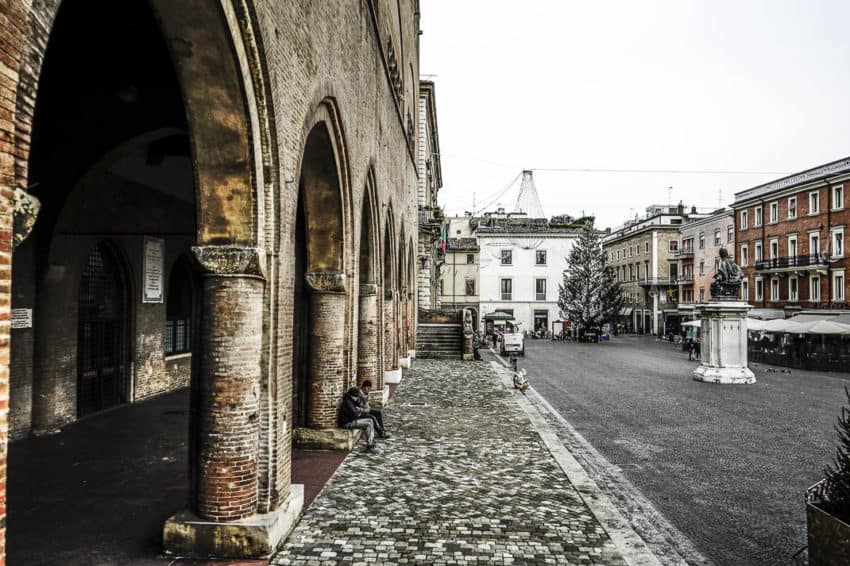
RIMINI, Italy — Like soccer, truffles and flu, tourism also has an off season in Italy. It’s from November through February. In December, except for the pilgrims pouring into St. Peter’s Square and skiers to the Dolomites over Christmas, Italy doesn’t seem more touristy than Indianapolis. That’s despite hotels dropping their rates and hardly any lines for museums. It’s not only a wonderful time to visit, it’s a fantastic time to live here. Restaurants aren’t full. You can actually breathe on buses. Yankees caps are hard to find.
I’m not a big weather guy. It’s a non factor when I travel except if I go to a beach. Then it had better be sunny or I blame myself and get hostile. But in mild, sunny Italy the weather only drops below sunbathing weather. In Rome, December temperatures range from about 40 to 55. January is the coldest month when it’s about 38-52.
So what? You’ll look good in an Italian scarf.
Some places in Italy are even advisable in the off season. In season? It may scare you off from anything Italian again. And who can live without pasta carbonara, Chianti and opera while cooking?

I’d never been to Rimini, the renowned beach town on the Adriatic. A former Las Vegas newspaper colleague who lived there warned me off it, saying you can’t see a speck of sand on the beach from all the bodies. Add in the long string of bars and clubs and Rimini sounded like Fort Lauderdale with wine instead of Bud.
With my girlfriend, Marina Pascucci, getting a long weekend earlier this month, I rented a car — much cheaper than Italy’s overpriced trains if you don’t include the gas — and drove us the 240 miles through Lazio and Abruzzo and up the coast into Emilia-Romagna. Marina was the perfect guide. Her mother has roots in Romagna and as a child Marina made frequent trips to Rimini to visit her grandmother. She remembers playing on the broad, sandy beach with her cousins and their families eating fried ciambelle (like a sugar-coated Italian donut) and listening to the music in the discos.
This was her first trip in 12 years.
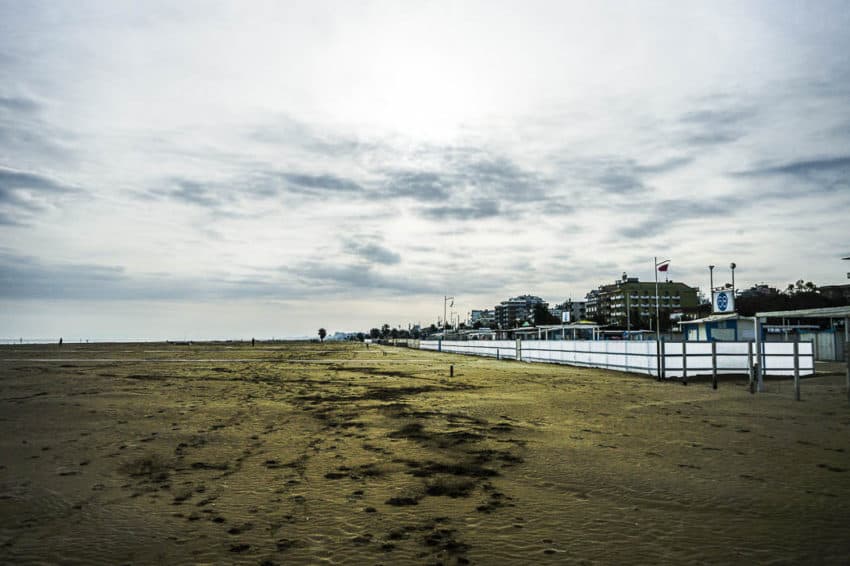
She had never seen it this barren. We crossed the street from our hotel and walked past all the changing cabins onto a narrow wood walkway into the wide expanse of sand. As beaches go, it’s spectacular in its functionality: pleasant brown color with nary a rock under my feet. It’s broad and its nine miles stretch on both sides to the horizon.
But, like all Italian beaches, it doesn’t have the gentle palm trees of the Western Hemisphere or the cliffs of Greece. I could imagine sidestepping the mosaic of lanais chairs on a 90-degree day in July. In fact, each partition of the beach is numbered so you don’t lose your place when coming back with a beer. Postcards make it look like the Jersey Shore in the ‘50s.
Instead, I counted five other people: three joggers, a man walking his dog and a woman going for a lonely walk. We were all wearing pants and heavy coats, not going near the cold, gray water on a day in the mid-40s. Still, Rimini and the Adriatic were magical in a mystical way. We heard no music. We heard no talking. We heard no cars. Just the sound of birds overhead and crushed sand under our feet. Marina pointed to the water, to Dubrovnik sitting on the other side of the Adriatic.
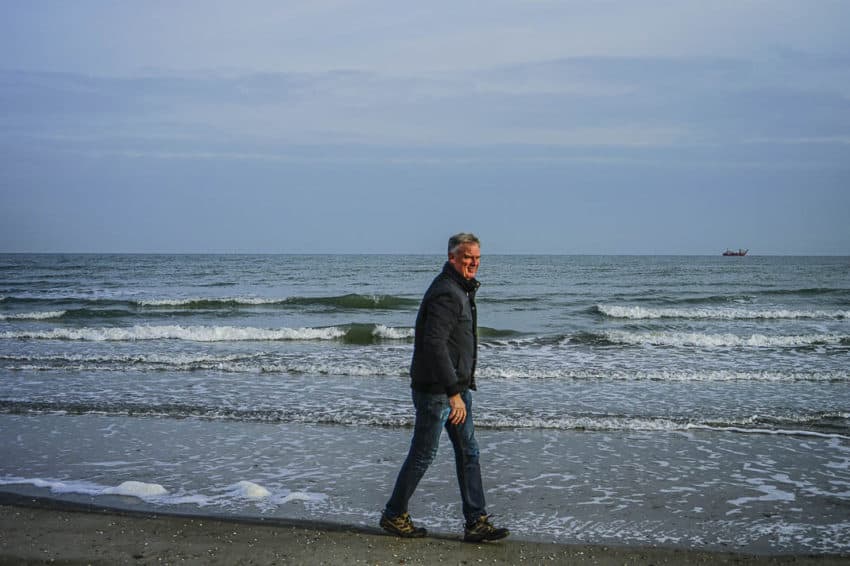
Rimini in winter would be a good place to write a book.
It’s bigger than I thought. Then again, so was Fort Lauderdale. Rimini has about 150,000 people and that many more tourists could fit in the string of hotels on the three long roads paralleling the beach. Most of the hotels could use a new coat of paint. Also closed were the tourist offices — with signs in Russian to appease the hordes of tourists taking the direct Moscow-Rimini flights in summer.
We stopped at Rimini’s tourist office where they told us only 300-400 of the 1,000 hotels in town were currently open. In fact, the number of tourists in July totaled 342,099 compared to 40,426 in February.
Too bad. What they’re missing are some amazing bargains. Marina found the four-star Hotel Diplomat Palace across the street from the beach for — get this — 65 euros for two nights. In July it’s 75 a night. That’s with a beautiful view of the sea and a full spa, complete with Jacuzzi, steam room and sauna. Oh, yes, did I mention the full breakfast buffet with food tables about 10 meters long?
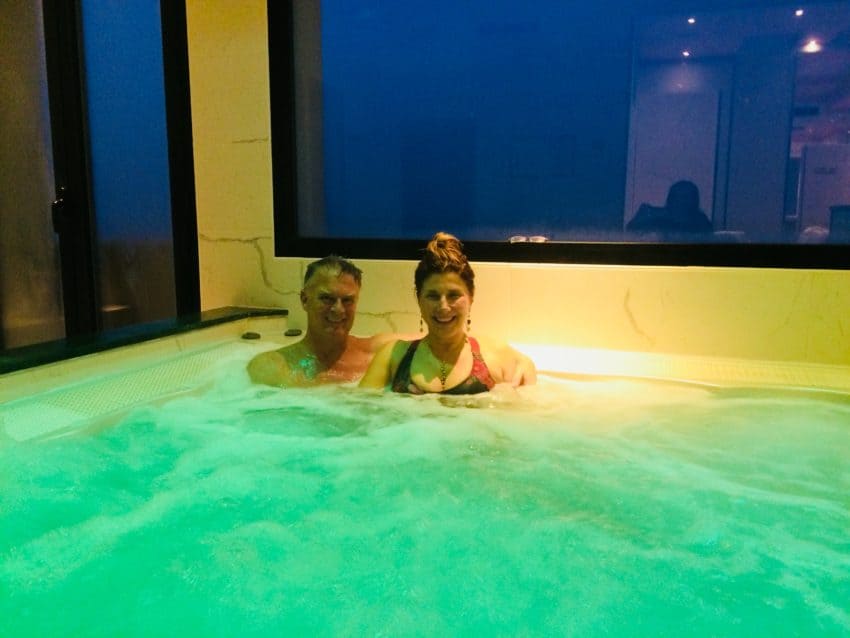
The hotel wasn’t close to full. In December, we felt as if we had the whole town to ourselves.
We walked through Rimini’s Centro Storico which is “storico (historic)” in name only. Allied forces bombed it into oblivion and the town rebuilt it into the tourist center it has become today. But unlike other bombed cities such as Frankfurt and Naples, Rimini built a charmless business center near Piazza Tre Martiri, named for the three civilians hanged there by retreating Nazis at the end of World War II. In place of centuries-run family trattorias and boutique shops as we find all over Rome are high-end European chains such as Stefanel, Furla and Max Mara. We had a coffee at an ultra modern coffee bar called Caffe Pascucci, which Marina distanced her family from as soon as she saw it had a frappuccino bar.
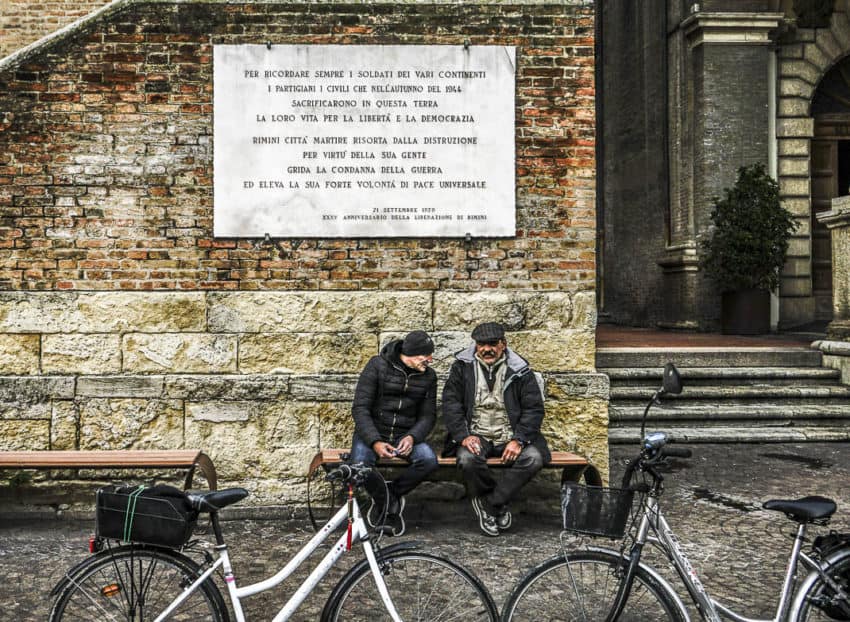
But Rimini’s Christmas decorations were tastefully done, just enough to give us a feel of holiday spirit without hearing Andrea Bocelli singing “Silent Night.” We walked under a string of wreaths over the narrow, romantic walking mall to Piazza Cavour, Rimini’s main square and truly majestic in its chilled solitude. A 50-foot tree awaited decorations while the usually bustling Caffe Cavour was only half full of people sipping wine next to space heaters at the covered outdoor tables. Bordering the massive piazza were the 16th century Palazzo del Municipio, Rimini’s city hall that was rebuilt after getting pummeled in the war, and the 14th century Palazzo del Podesta, a beautiful Gothic palace. Its three arched entryways and miniature turrets make it look like a small castle.
Rimini has other historic aspects that haven’t turned into an international chain store. From Piazza Cavour we walked across Ponte di Tiberio, built from 14-21 AD by Caesar Augustus and Tiberius whose Roman armies used it as a connector between the Adriatic Coast, the Po River valley in Piacenza and Via Flaminia, the main northern access to Ancient Rome. The 70-meter bridge is still in use and boats float under its five arches down the Marecchia River. The bridge’s black and gray splotches from centuries of exhaust fumes add to its historical allure.
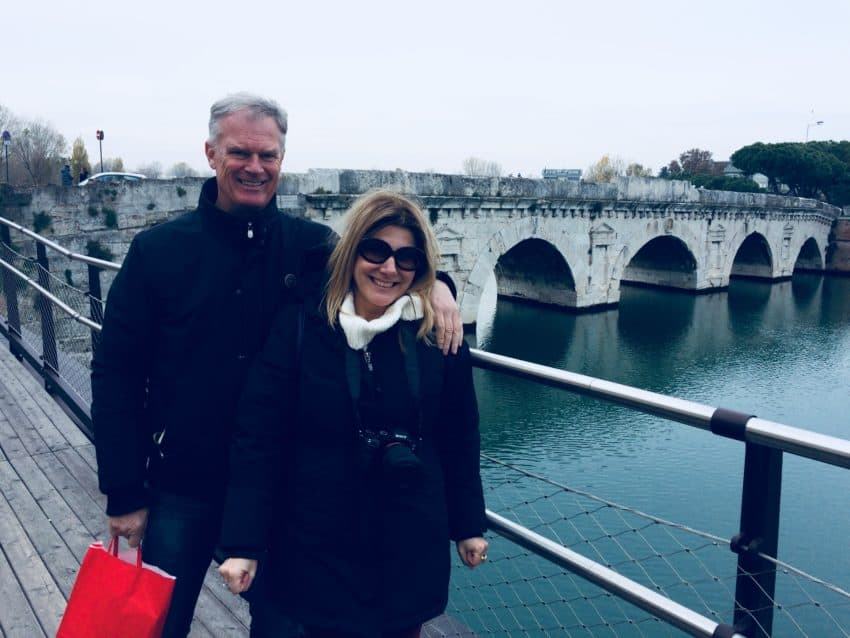
The bridge connects Centro Storico with Borgo San Giuliano, Rimini’s old fishing quarters which the city brightened up with fresh coats of orange, yellow, white and beige paint but didn’t sacrifice its homey charm. The borgo (Italian for a neighborhood outside an historical center) is a mishmash of narrow alleys with colorful buildings and quaint bars and restaurants. We saw a colorful poster advertising the showing of “Le Notti di Cabiria,” the 1957 film directed by Rimini’s most famous native son.
Federico Fellini.
Yes, while Italian cinema (with the exception of Oscar-winning director Paolo Sorrentino) has slumped to nearly the depths of its awful TV programming, the inspiration of its heyday began in Rimini. Born in 1920 to a traveling salesman who came from peasantry and a wealthy Roman mother, Fellini went to a Rimini school run by nuns and spent his time drawing and directing puppet shows. He became a teenager during Mussolini’s Italy and joined the Avanguardisti, the compulsory Fascist youth group for boys. He soon began writing and believed in using his Rimini childhood in many of his films. The sea creature at the end of his “La Dolce Vita” was inspired by a giant fish washed ashore Rimini’s beach by a storm in 1934. In 1937 he opened a portrait shop in Rimini and in 1939 moved to Rome to begin law school to appease his parents. He never attended a class.

The city is working on a Fellini museum in his old home near the train station but it won’t be completed until next year.
Rimini’s one must-see is Tempio Malatestiano. Italy is full of huge churches decked out in amazing frescoes but this is the only one I know dedicated to a man whose effigy was burned in Rome. It was built in the 13th century on the behest of Sigismondo Malatesta, known as the “Wolf of Rimini” for his particularly brutal war style. Pope Pius II wasn’t too crazy about his litany of murder, rape, incest and adultery, not to mention general overall oppression of people. The pope torched his effigy and condemned him to hell then subsequent Papal forces took most of his land in battles in 1468. Ol’ Sigismondo’s sarcophagus is near his mistress’ (see above: adultery) on one side of the church. His tortured soul has yet to be found.

The beauty of off-season traveling in Italy is it doesn’t matter how many places have closed. You only need one hotel room; you only need one restaurant table.
And Italy’s food has no off season.
Every region that you travel, no matter when you go, a different cuisine awaits you. In Emilia-Romagna you don’t need beaches or nightclubs or museums. Just eat. Behind Sicily it’s my favorite food region in Italy. And its antipasti is No. 1. The Parma ham served so lean and the parmesan cheese you eat like bonbons are absolute musts before every meal. Also from Emilia-Romagna comes ragu, the famous meat sauce flavored with white wine, tomato, oregano and pork belly.
Our first dining stop was Osteria Borgo Marina, a small, simple diner run by an Albanian woman who has lived here for years. Borgo Marina is famous for its mixed antipasti plate and we started with a big serving of pecorino romano cheese, salami, prosciutto and a warm basket of bread. I’d been salivating over ragu since we left Rome. Her tagliatelle ragu didn’t disappoint, a fantastic meaty sauce over those long, wide homemade noodles. Marina had the best breaded calamari of her life, a life spent entirely in Italy.
Rimini specifically is the birthplace of the piadina, a sandwich made of flatbread cut open and filled with anything from meat to fish to vegetables. The best piadini joint in Rimini is Nud e Crud, just over the Ponte di Tiberio in the borgo. We walked in to a jam-packed enclosed outdoor seating area where two harried waiters seated us in the crowded corner. The menu features 32 different piadinas, everything from salsiccia rucole e formaggio fuso (sausage, arugula and cooked cheese) for 6.50 to fillet di cefelo (a local fish) for 10.90. I had the crudo e squacquerone, raw prosciutto with a white, gooey cheese that tasted like a five-star ham and cheese sandwich. We sat next to the only four tourists we saw all weekend: a young couple from Sicily and a middle-aged, well-heeled couple from Venice.
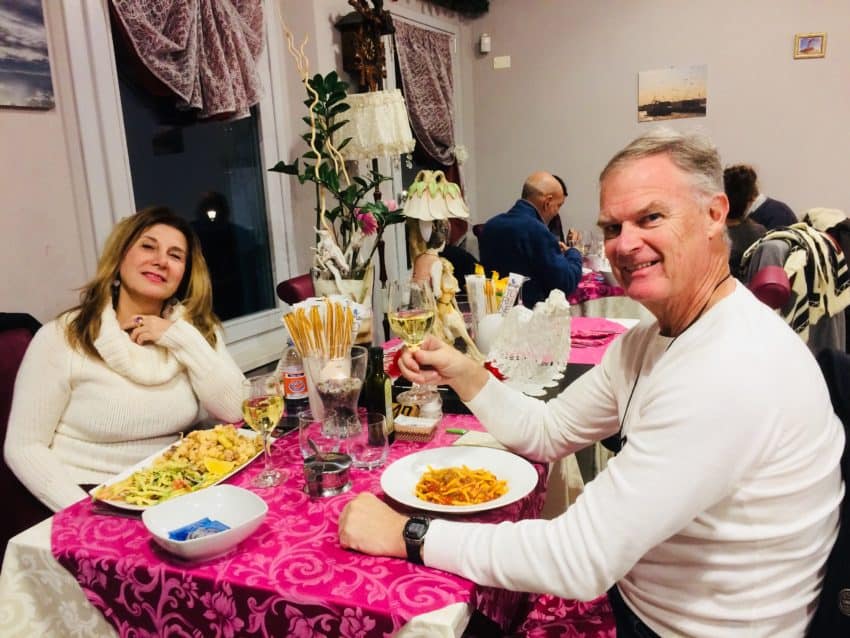
The second night we went to the back of beyond. We drove to Cesanatico, a former port town turned beach resort 13 miles north of Rimini with 25,000 people and one of the most charming harbors in Italy. We were at one of only two tables occupied at Ca’ Nostra (“Our Home” in the Romagnolo dialect), an elegant harborview restaurant with beautiful purple place settings offsetting the annoying Italian music videos on the TVs. I had great ragu strazzapreti (Italian for “strangle priests” which the little twisty pasta seems capable of doing) with a local Trebbiano wine. With a 20-percent discount from The Fork, the booking agency, our total meal was only 33.20 euros. I’ve had more expensive meals in Mexico.
Afterward, we walked arm in arm, mostly for romance but also to shield against the 39-degree temperature, as we strolled under the Christmas lights hanging over the cobblestone streets. We passed no high-end businesses or chains. Just some warm cafes and wine bars filled with locals waiting for the holidays to begin.
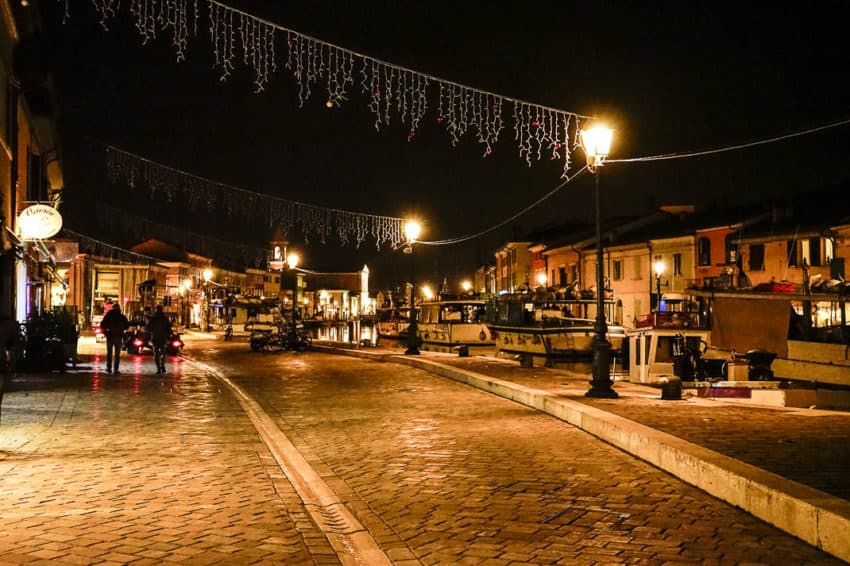
And they were enjoying a time without tourists — that is except for the two walking past them who were here for the same reason. We came home without a tan but with lots of extra money and filled with great food and memories.
Italy … where for us, there is no off season.


December 14, 2018 @ 8:36 am
We were not quite as off’season as you, but we were delighted with the peacefulness of Pesaro in early October 2017. Prices low and crowds nowhere to be seen. https://girovaga.com/2017/10/11/off-the-beaten-le-marche/